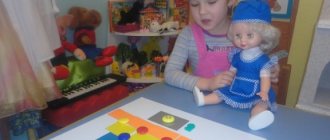Development of fantasy
In preschool educational institutions (DOU), mnemonic tables can be used to develop thinking and imagination. You should start with simple signs that depict objects denoted by one word or phrase. There are 4 signs in total. Then the task becomes more complicated. The teacher should arrange the cards in the form of a square. Following the path of the square, children must compose a short story of two or three sentences. At first, you can ask children leading questions. Then we can offer mnemonic tables with the help of which a whole story is compiled. Also, using these tables you can simplify the task of memorizing a story or poem.
At first, the teacher compiles mnemonic tables. When children have sufficiently grasped the essence of mnemonics, they can begin to be introduced to the process of creating tables.
What is mnemonics
The concept is associated with a system that helps to assimilate large amounts of information. These are exercises that help evoke associations and remember. Associations can be kinesthetic (tactile), visual (visible), auditory (auditory).
How to remember a date from history?
Imagine that this is the day and month of “your acquaintance” with a historical character. Or the day when “you visited” the site of a historical event.
Everyone can associate differently. The task of parents is to teach the child to find the association on his own based on examples and remember it. And then reproduce it in memory.
Junior group
In the younger group, you can use mnemonics to easily remember the sequence of different processes (the method of auditoryization, not visualization, already works here). For example: hand washing sequence. Open the tap → take soap → soap your hands → rinse your hands → close the tap → dry your hands with a towel.
The same method can be used to teach the sequence of dressing, brushing teeth, etc.
Using mnemonic diagrams, it is good to tell children about animals, insects, and birds. Using mnemonic tables you can create a riddle. You need to cover several cards so that the children can guess what is shown on them. For example: The picture shows a hare. The teacher closes the next picture and asks where the hare lives (in the forest). What does a hare eat? (grass, stems, tree bark). What color is a hare's coat? (gray, white). After the children have answered the question, the picture needs to be opened. If the children find it difficult to answer, the teacher gives hints or answers himself.
Books on mnemonics for children
- “Learning from a fairy tale”, T.V. Bolshakova;
- “Supermemory for everyone”, E.E. Vasilyeva, V. Yu. Vasiliev;
- “Remember everything. Practical guide to memory development”, Arthur Dumchev;
- “Brain development. How to Read Faster, Remember Better, and Achieve Bigger Goals by Roger Sipe;
- “Einstein walks on the moon. The Science and Art of Memory,” Joua Foer;
- A. R. Luria. “A little book about a big memory”;
- How to Develop Super Memory by Dominic O'Brien.
The books describe in detail common techniques, proprietary methods, give tips on mastering and demonstrate the work with examples.
Middle group
Increasingly, in preschool educational institutions, this technique is used not only by teachers and speech therapists, but also by other specialists: music director, physical worker, art teacher. The use of mnemonics for preschoolers is very important in the work of a defectologist.
In the middle group, mnemonics can be used to develop attention, imagination, and creative abilities. Also, using mnemonic tables, children can be taught to memorize poetry. With the help of mnemonics, children develop taste, tactile, visual, motor and auditory memory.
Every year there are more and more children with limited vocabulary. Children's speech consists of simple sentences using non-literary words. It often happens that a child cannot correctly formulate his question or answer. Many children are not able to retell even a short text. The use of mnemonics for preschoolers helps educators solve these problems.
For mnemonics in the middle group, they use not only pictures, but also geometric figures, symbols, plans, and silhouette images. With the help of mnemonics, you can teach your child not only to guess, but also to make riddles, which will also have a positive effect on speech development.
LiveInternetLiveInternet
Quote from the message to MY_GRANDCHILDREN_USEFUL
Read in full In your quotation book or community!
Mnemonic tables are a wonderful technique for composing descriptive stories and memorizing poetry.
On my own behalf, I will say that it is a very good thing for the topic SPEECH DEVELOPMENT. This especially helps when composing descriptive stories and memorizing poetry. And, of course, sound automation.
Our speech therapist Elena Nikolaevna gives us short poems at every lesson, and I (although I’m never an artist) draw, and more often copy simple pictures from the Internet, make a mnemonic table and print it out. And my granddaughter and I teach. I am now collecting a lot of pictures in my diary, as well as ready-made mnemonic tables on various topics.
This is such an important topic that I highlighted MNEMOTECHNIQUES in my diary as a separate section.
FROM THE AUTHOR: “Mnemonics is a set of rules and techniques that facilitate the process of memorizing information. Mnemonics helps to develop: - associative thinking!!!!!!!! - visual and auditory memory!!!!!! - visual and auditory attention!!!!!! — imagination !!!!! An example of mnemonics is the familiar phrase “Every Hunter Wants to Know Where the Pheasant Sits,” which helps to remember the colors of the rainbow.
Mnemonic tables are especially effective when learning poems. The bottom line is this: for each word or small phrase, a picture (image) is created; Thus, the entire poem is sketched schematically. After this, the child reproduces the entire poem from memory, using a graphic image.
Mnemonic tables for learning poetry
(by the way, pay attention to how simple the drawings are, even a “never-artist” can handle them)
4.
5.
6.
7.
8.
9.
10.
11.
Mnemonic tables for compiling descriptive stories. SEASONS. COMPILATION OF DESCRIPTIVE STORIES USING MEMONIC TABLES Spring: The letter “B” means that spring has come. The sun heats up more strongly and it becomes warmer. The letter “U”, snowflakes - the snow is melting outside and streams are running. Girls, boys, a boat - children launch boats on the water. Trees, birds - green leaves appear first, migratory birds return from hot countries.
Summer: Letter “L” - summer has come. The sun is shining brightly, warming, scorching. Girls and boys swim in the river, play badminton and ball, and build towers out of sand. In summer, delicious fruits, berries and healthy vegetables ripen. Autumn: Letter “O” - autumn has come. The sun is behind a cloud - the sun was hidden by dark gray clouds. Umbrella – it often rains and strong winds blow. Tree, yellow leaves – the leaves on the trees are turning yellow. A lot of leaves cover the whole ground with a beautiful carpet. Winter: The letter “Z” means what? (winter has come) Cloud - the sky is hidden by dark clouds. Snowflakes – cold snow often falls. Girls, boys and the letter “U” - they are walking on the street. Snowman - making snowballs and a snow woman out of snow. Skates, sleds - skating and sledding
Summer
Autumn
Winter
Spring
Mnemonic tables for sound automation
To automate the sound L
Series of messages “.MNEMOTECHNIQUES, MNEMOTECHNIQUES”:
Part 1 - !!!!!!!! Automation of sounds, sound tables Part 2 - Memorizing poetry using mnemonics... Part 6 - Mnemonic tables - very easy to perform!!! Part 7 - Mnemotechnics Part 8 - Mnemotables - a wonderful technique for composing descriptive stories and memorizing poetry Part 9 - LEARNING VERSES USING TABLES Part 10 - Memorizing poems using mnemonics tables
Designer: Tatiana Belan
Mnemonic tables serve as an excellent hint for successfully memorizing the content of songs, thanks to which the child learns the material much faster and more effectively, his vocabulary and visual perception are enriched and activated, thanks to bright, consistent illustrations. We present to your attention 18 colorfully designed mnemonic tables for working on the autumn song repertoire during music classes in kindergarten with children of middle and senior preschool age. Music and text material for working on our tables can be easily found and downloaded on the Internet; we offer only a selected and graphically designed illustrative set.
1. “Oh, what autumn”, music. etc. Z. Root 2. “Mushroom”, music. A. Beloborodova, lyrics. O. Vysotskaya 3. “Golden Song”, music. G. Vikhareva, lyrics. Z. Petrova 4. “Wet day”, music. V. Volkova, lyrics. E. Karaseva 5. “Osenin-names”, music. etc. E. Gomonova 6. “Autumn Tears”, music. etc. G. Vikhareva 7. “Autumn Waltz”, music. etc. E. Shalamonova 8. “Autumn has come,” music. etc. S. Nasaulenko 9. “Autumn, autumn”, music. N. Lukonina, lyrics. L. Chadova 10. “Autumn the Artist”, music. etc. Z. Root 11. “Autumn put on a sundress,” music. T. Potapenko, lyrics. I. Chernitskaya 12. “What will autumn bring us?”, music. Z. Levina, lyrics. Y. Akima
Includes 18 tables for color printing in A4 format, cover + sheet with a list of song repertoire
Recommendations for working with tables - PDF file
The materials are sent in electronic form - a compressed archive file, for independent downloading and printing (pictures in JPEG format).
File size - 57 MB
- Delivery of materials is carried out automatically within a few minutes after payment to your email address specified when placing an order.
- If the letter is not in your inbox, please check your spam folder.
- When filling out the order form, please make sure your e-mail address is correct!
COST OF THE SET—180 rubles
After clicking the button, you will be taken to the product page in Robo.market
Payment is made through the Robokassa
via a secure protocol. You can choose any convenient payment method.
Before purchasing, please read the terms of supply of materials and answers to frequently asked questions
How to place and pay for an order
Protected by copyright law.
Copying, transfer to third parties, posting on the Internet,
and commercial use of site materials is strictly PROHIBITED.



